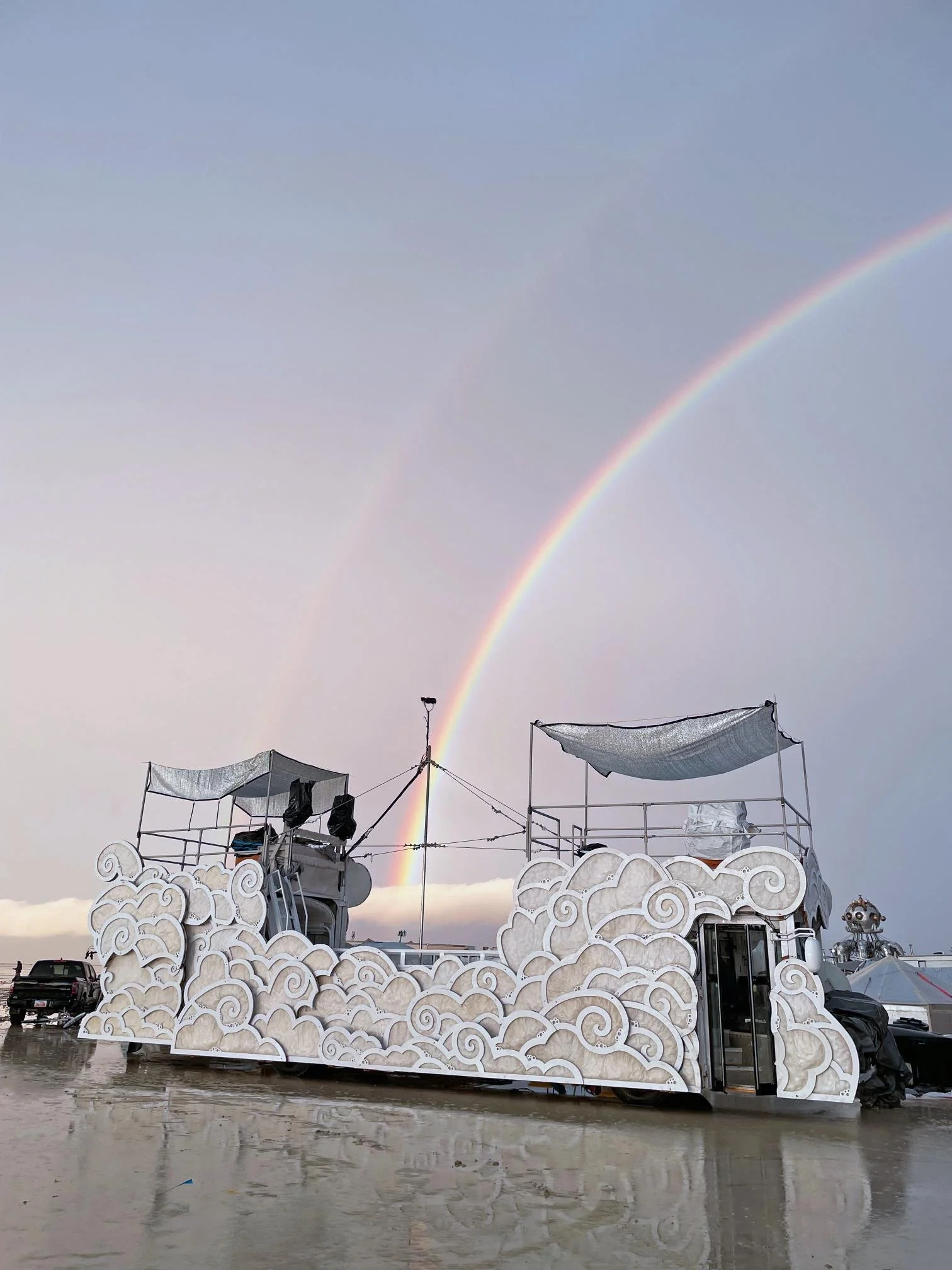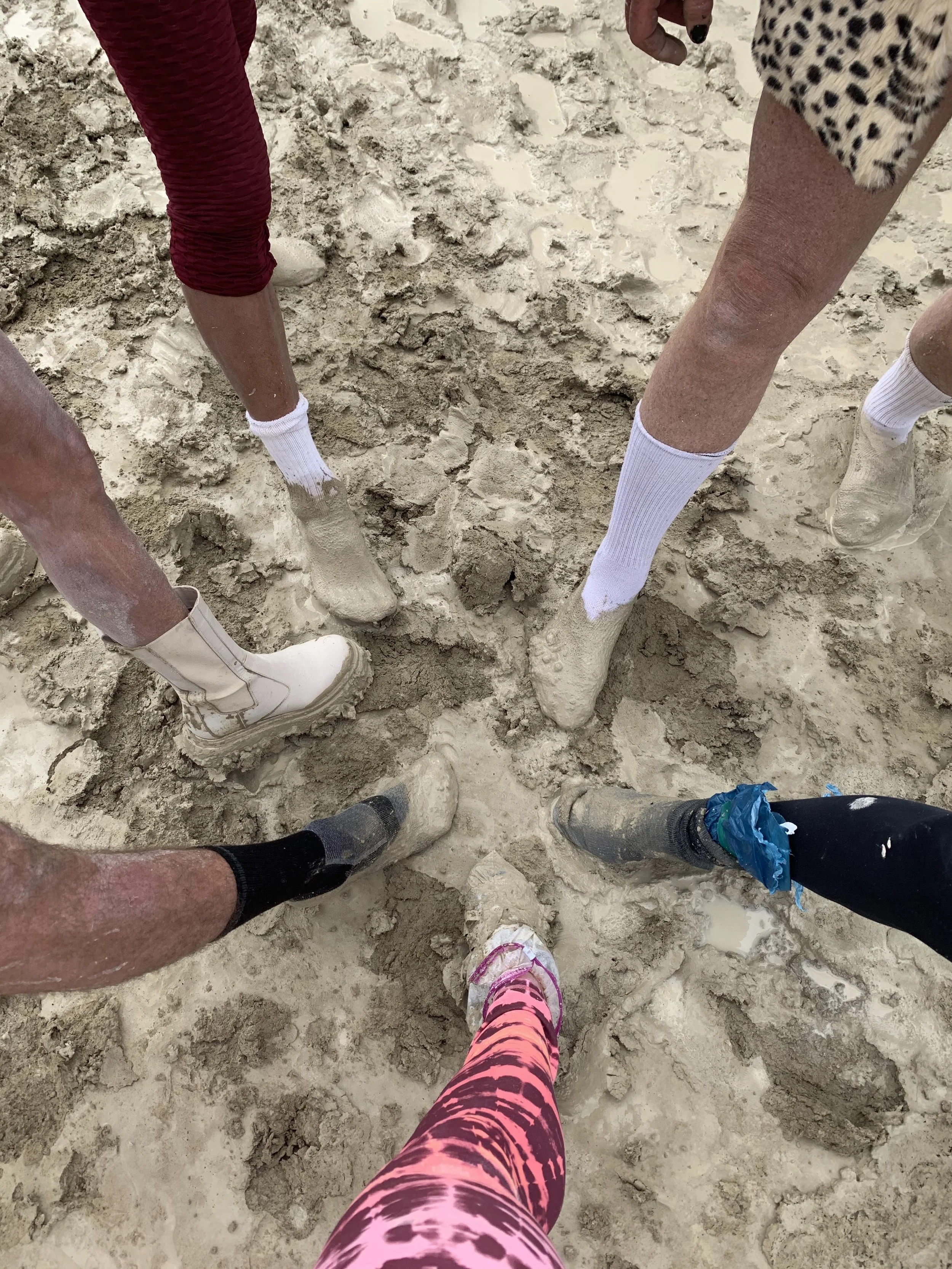Commentary: I wasn't ‘stranded’ at Burning Man
Sept. 19, 2023 | By Cara CapparelliCapparelli's Burning Man camp mates' art vehicle, "Fluffy," debuted at the festival in 2022. Waterbury resident Duane Peterson drove the converted bus to and from the event this year. Photo by Jenn Kelly
I missed most of the news of Burning Man this year as I was there, without internet service. But the news got in. We heard the front page of the New York Times had declared us stranded. We heard FEMA was staging nearby. We were to be part of a disaster.
Our camp of 45 people is set up by veteran Burners and we are beyond organized (Yes, we have laminated spreadsheets). But even our most seasoned member with 17 Burns under his furry tail kept looking at the mud and saying, “This is weird.”
Weird it was. We were well-prepared for dust and heat and even cold, but mud was not really part of the reckoning. And the mud – oh the mud. After the Friday rains, to even venture out of your tent and into the slop took enormous will and preparation. We experimented with all sorts of foot coverings to fend off the caking that instantly produces platforms of clay on soles. When the mud was really wet, socks were best. I preferred the layering of sock/plastic bag/sock method. Others just went for bare feet. But both left you with pruney skin before long and risked the danger of trench foot. Also, constantly taping bags to your ankles gets old fast. I switched to the sock/bag/shoe/sock-over-shoe method which was golden – dry feet and no sticky mud. Communal sessions of vinegar foot baths (using our melted cooler water) helped keep our tootsies happy and our spirits high.
This form of industriousness was crucial in attempting to camp inside a lake. Not by a lake, but in it. The Playa, the beloved home of Burning Man in Nevada’s Black Rock Desert for the last 32 years, is in fact a prehistoric lake bed made of silt that turns to slick clay with the slightest of precipitation. The mere (by Vermont standards) .8 inches of rain that fell in one day was enough to surround us in standing water that would take 48 dry hours to dissipate. Everything came to a standstill and we were told to "shelter in place." The pinnacle "Man Burn" for Saturday night was postponed. Was it all now over? Some people panicked. Despite being asked not to, as early as Saturday people started attempting to drive out of the temporary city. Our camp was on a main exit street and we sat and watched as RV after RV got buried and spun and turned the roads to rutted mush. Some people walked out to the road hoping to get a ride to the nearest town of Gerlach, 12 miles away. To be sure, some people needed to go. They had responsibilities, people relying on them, or international flights that would be difficult to reschedule. But many people just couldn't deal with the discomfort. They wanted out and they didn't think they could wait. So they tore up the roads and abandoned vehicles and left their garbage and soggy furniture. In Burning Man lingo, we call that “Doing it Wrong.”
Coping with the mud at Burning Man. Photo by Jenn Kelly
In our camp, there was no panic. Not for one minute did I feel unsafe. We made dry spaces where we could. We had plenty of food and water. We designated pee buckets. We danced. We laughed. We took care of each other and took in others whose camps were stressed.
One mud morning someone got service and was reading news about how terrible it all apparently was, and at that moment we were dining on French toast with fresh blueberries and Vermont maple syrup, and of course mimosas. We kept our routines and slogged through three days of mud until the sun finally returned on Monday. We started the long clean-up, digging to unearth cardboard and socks sucked into the drying ooze. Amazingly, things returned to normal.
The Man burned Monday night and as I again got to ride my bike across the dry playa, I felt more than ever, that those of us who remained had earned this label of “Burner” in the best sense of radical self-reliance and communal effort. I know all the criticisms. Yes, it's a created environment and a party, and it has many, many problems. It's also an amazing moment in art and time where people connect in ways that we only dream of in the default world. It's a test of my physical, emotional, and social grit and it gives me hope.
When we finally departed the square of playa assigned to our camp, the road was dry and we left only footprints. Among the things we carried with us were our once-soggy and now sun-salvaged couches, ready to Burn again.
* * * * * * * * * * * *
The annual Burning Man event took place Aug. 26-Sept. 3 in Black Rock City, a temporary, remote encampment of approximately 70,000 people who travel to northwestern Nevada. It’s named for the festival’s highlight where a large wooden-man effigy is burned. Since 1992, the gathering has been known for its focus on community, art, self-expression, and self-reliance.
Among Capparelli’s camp mates were Waterbury residents Duane Peterson and John Bauer. Peterson drove the camp’s showpiece art vehicle, Fluffy, to and from the event logging more than 5,000 miles. The converted school bus debuted at the 2022 Burning Man and was featured by Seven Days newspaper then and last week in a follow-up where Peterson – the now retired co-founder of SunCommon and 17-year Burning Man veteran – called it the “silver lining” of this year’s unusual circumstances. Read that account at SevenDaysVt.com.
The author Cara Capparelli on the right with Burning Man campmate Jenn Kelly of Oakland, California. Courtesy photo
Cara Capparelli lives in Duxbury.



